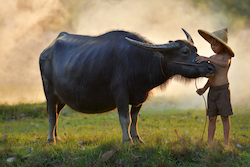Could farming be the reason behind post-Neolithic wealth disparities?
Charting wealth distribution gives us an insight into the character of a society: where power was situated, possibilities of social mobility, the ebb and flow of trade. In prehistoric cultures where there are no written records, the presence of indicators of wealth, such as grave goods or objects that has been imported, have been put forward a way to identify wealth. But the former are not household goods and the latter could have found their way into a site without necessarily having been ‘bought’ by those living there. These ‘proxies’ for wealth, according to a letter recently published in the journal ‘Nature’, do not answer the many questions surrounding disparity, such as the relationship between farming and a society’s wealth, or the impact of sociopolitical dynamics. The researchers suggest using house size distributions that provide, they suggest, a consistent metric. The study is based on data gathered from a research team that analysed 63 archeological sites across four continents, dating between 9000 B.C.E. and 1500 C.E. It is one of the first studies to use archaeological data to measure inter-household inequality between Old and New World sites. More efficient farming generated wealth Their research, in part supported by the EU’s AGRICURB project, suggests that the higher wealth disparity identified in post-Neolithic Eurasia was initially due to the availability of larger animals that could be domesticated. People became less nomadic and more dependent on agriculture. The rich became richer as the ancient farmers who could afford oxen, cattle and other large animals increased their crop production. This created profit, which was then amassed and passed on, causing wealth inequality. The study revealed that house-sizes point to the inequalities being much higher in Old World Eurasian contexts. ‘High degrees of inequality did not contribute to long-term stability in ancient societies,’ says Anna Prentiss, a professor in the Department of Anthropology at the University of Montana and one of the paper’s authors. ‘That is something that should concern us, given the extraordinary high degree of inequality in our own society.’ Wealth as a tool of militarisation and expansion The flow and circulation of wealth lead to the development of a mounted warrior elite, suggest the researchers. Such warriors would have been instrumental in expanding polities, (political units that cohere via identity, ability to mobilise resources, or governance), to sizes that were not possible in North America and Mesoamerica before the arrival of Europeans. The paper consolidates a generally held view, based on comparative studies of farming societies: that the greater the surpluses a society produced, the greater the levels of inequality in that society. The need for ever greater access to land also leads to disputes over resources, war, conquest and geographical expansion. AGRICURB recognised that farming is a pivotal moment in human history, setting the stage for the emergence of class-based society and urbanisation. The project, which closed at the start of 2017, took a novel, interdisciplinary approach combining archaeobotany, plant stable isotope chemistry and functional plant ecology to gain new insight into early farming and its relationship with early civilization. For more information, please see: Project website
Countries
United Kingdom



